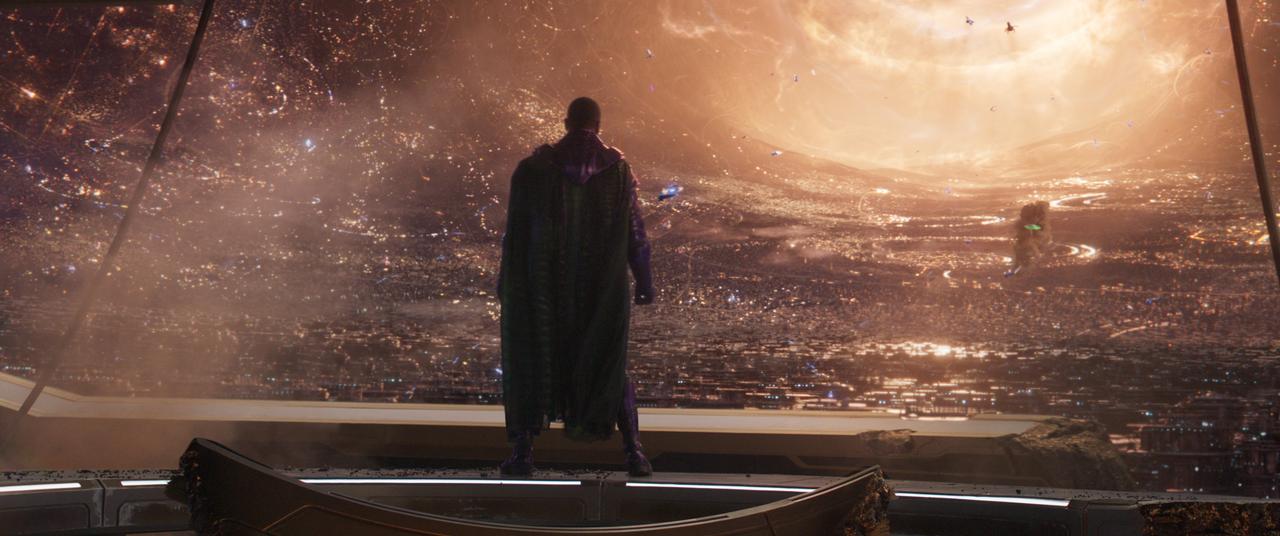If you click on a link and make a purchase we may receive a small commission. Read our editorial policy.
Who is Kang in Ant-Man and the Wasp: Quantumania?
As the Marvel Cinematic Universe enters time of The Kang Dynasty, here’s how Kang is set to become the most important figure in the MCU.

If the first three phases of the Marvel Cinematic Universe all led up to a final confrontation against the villainous Thanos, the fourth through sixth phases have been heavily informed by Kang the Conqueror. Played by Jonathan Majors, a Kang variant made his on-screen debut in the Loki Season 1 finale to warn the God of Mischief and his multiversal variant Sylvie of more evil Kang variants poised to endanger the entire Marvel Cinematic Multiverse. Now that Ant-Man and the Wasp: Quantumania has hit theaters, here's some (non-Quantumania spoilers) information on how Kang is shaping up to be the most important figure in the MCU for the foreseeable future.
Here is an overview of Kang the Conqueror, from his comic book origins and wide array of powers and abilities to his evolving role in the MCU. With Majors reprising his role as Kang in a much more sinister way in Quantumania, the reality-hopping Conqueror is set to become the face of superhero movie villainy for the next several years.
If you want a spoiler-free peek at how Kang appears in Quantumania, read our Ant-Man and the Wasp: Quantumania review here.
Who is Kang?

Kang was introduced by Stan Lee and Jack Kirby in 1963’s Fantastic Four #19 under the guise of Rama-Tut, with the implication that he was Doctor Doom’s time-traveling son from the future who travels to Ancient Egypt to rule it before he is pursued and defeated by the Fantastic Four. Taking on the moniker of Kang the Conqueror for the first time in 1964’s The Avengers #8, the villain confronts Earth’s Mightiest Heroes and becomes a recurring threat for the superhero community, armed with weaponry from across space and time. John Byrne would expand on Kang’s background in 1984’s Fantastic Four #273, revealing him to be Nathaniel Richards, the descendant of Reed Richards’ time-traveling father, who grew up in the 31st century and turned to a life of crime and conquest enabled by his time-traveling technology.
A similar time-traveling figure, Immortus, was introduced by Lee and Kirby in The Avengers #10. Immortus headed the Time Variance Authority (TVA) which governed the space-time continuum and occasionally served as an ally or enemy to the Avengers. 1975’s Giant-Size Avengers #3 by Steve Englehart, Dave Cockrum, and Joe Giella revealed that Immortus was a future iteration of Kang who was more world-weary and less reliant on violence (though no less manipulative in his oversight and maintenance of the various timelines). The existence of multiple Kangs was explained in 1986’s The Avengers #267 by Roger Stern, John Buscema, and Tom Palmer, revealing that Kang’s constant time-travel and meddling with the timestream resulted in a wave of Kang variants being created.
Another notable form of Kang was introduced by Allan Heinberg, Jim Cheung, and John Dell in 2005’s Young Avengers #1. After Kang tries to goad his teenage self to turn to villainy even earlier in his life, teen Nate Richards time-travels to the early 21st century instead, taking on the superhero moniker of Iron Lad and serving on the Young Avengers. Realizing that the only way to maintain the integrity of the space-time continuum would be to travel back to his own time and embrace his twisted destiny, Nate later travels back to the 31st century to become Kang.
Kang’s Powers & Abilities

Technically, Kang possesses no naturally occurring superhuman abilities, though he boasts a genius-level intellect which he has used to extensively study the breadth of human history and its growing number of timelines. Through his studies and travels, Kang has mastered a number of martial arts techniques and forms of advanced technology that make him especially formidable.
Kang’s headquarters contains a vast armory of weapons, vehicles, and equipment that the Conqueror uses expertly. Kang is virtually always wearing his advanced set of futuristic armor from the 40th century that gives him superhuman strength, speed, and endurance along with the ability to generate energy projections that can be used both offensively and defensively.
How Kang Fits in Marvel Cinematic Universe

The MCU Disney+ original series Loki saw a variant of the Norse God of Mischief intercepted by the TVA after escaping from his alternate timeline that took place in the 2019 film Avengers: Endgame. In the series, Loki teamed up with another runaway variant of himself named Sylvie and learned that the TVA was created and led by a mysterious figure known simply as 'He Who Remains,' based within a Citadel at the End of Time. With Sylvie intent on killing He Who Remains out of revenge, she and Loki ventured into the Citadel and were shocked to discover that He Who Remains was just a man.
He Who Remains introduces himself as a scientist from the 31st century that created the TVA after multiversal variants of himself sparked a war against each to conquer their respective universes and timelines. He Who Remains harnessed the power of a creature known as Alioth and used it to isolate his timeline, with the TVA enforcing the prevention of any divergent timelines forming that would threaten its integrity. Having supervised the timeline for so long, he wearily offers the trickster variants the opportunity to either succeed him in leading the TVA or to kill him and cause the protective walls of the timeline to come down and risk Kang variants attacking.
Sylvie kills He Who Remains, and the timelines comprising the multiverse begin to expand and diverge uncontrollably. Meanwhile, Loki is sent to an alternate timeline where he sees a version of the TVA apparently led by a much sterner Kang variant. A Kang variant is set to appear in Quantumania, forcing Scott Lang to steal something from the Quantum Realm for him, kidnapping Scott’s daughter Cassie to ensure his cooperation. May 2025 will also see the release of a film titled Avengers: The Kang Dynasty, set to feature Kang in a major way.
Where Kang May Be Headed Next

While some of Kang's next appearances have been announced, the character’s relationships and looming presence over divergent timelines and the wider multiverse virtually guarantee he will be seen behind the next slate of MCU movies, starting with Ant-Man and the Wasp: Quantumania.
As for the future of Kang, one of the most eagerly anticipated projects, rife with fan speculation, is the introduction of the MCU’s Fantastic Four. Marvel’s First Family is set to star in their own film in November 2024 and, given Kang’s origins in the pages of Fantastic Four and his familial link to Reed, he may play a major role in the upcoming film.
During the time Nate Richards was on the Young Avengers in the comics, he struck up a relationship with his teammate Cassie. Kang targeting Cassie in Quantumania in order to coerce Ant-Man into working for him could foreshadow a younger variant of Kang similarly playing a role on the MCU equivalent of the Young Avengers as the shared universe introduces a new generation of heroes like Ms. Marvel and the new Hawkeye Kate Bishop.
And then there’s the matter of the Vision and the Scarlet Witch. The star-crossed Avengers couple have figured into different versions of Kang’s plans before in the comics, while Immortus would be the one who officiated Wanda Maximoff and Vision’s wedding. Immortus initially planned for the Scarlet Witch to supervise all of time, perhaps setting up the character for redemption after her villainous turn in Doctor Strange in the Multiverse of Madness. Iron Lad used his armor to resurrect Vision before becoming Kang in Young Avengers, potentially teasing how White Vision regains his memories after the events of WandaVision.
Beyond The Kang Dynasty is Avengers: Secret Wars, set to open in theaters November 2025. Considering that Kang appears in the comic book Secret Wars by Jim Shooter, Mike Zeck, and Bob Layton, we can assume that a variant of the Conqueror may appear in the MCU film, potentially as part of the multiversal war that He Who Remains warned Loki and Sylvie about. About the more near future of Kang's impact on the MCU, it's worth considering that Doctor Strange was last seen scrambling to stop multiversal incursions, perhaps spurred on by Kang variants, and that Loki, at the end of his show's first season, found himself in a timeline ruled by a Kang variant.
Wherever Kang shows up next, one thing is certain – The multiversal figure is about to become the most important face in the MCU for the next several years.
Ant-Man and the Wasp: Quantumania gets lost in its own changing sense of scale
Ant-Man 3: Everything you need to know from the trailers, the cast, the plot, and more to Ant-Man and the Wasp: Quantumania
Follow Popverse for upcoming event coverage and news
Find out how we conduct our review by reading our review policy
Let Popverse be your tour guide through the wilderness of pop culture
Sign in and let us help you find your new favorite thing.
















Comments
Want to join the discussion? Please activate your account first.
Visit Reedpop ID if you need to resend the confirmation email.